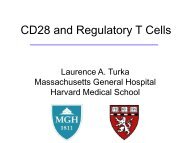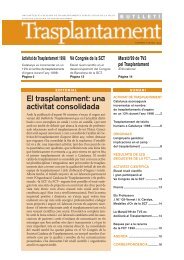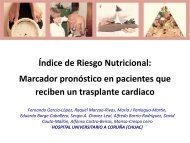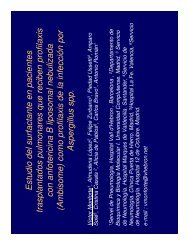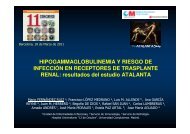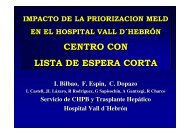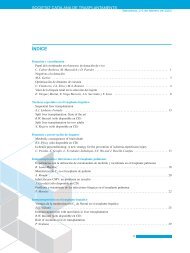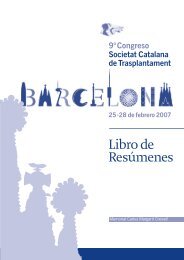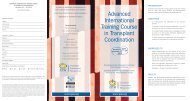Biopsias de protocolo de trasplante renal de donante vivo ABO ...
Biopsias de protocolo de trasplante renal de donante vivo ABO ...
Biopsias de protocolo de trasplante renal de donante vivo ABO ...
- No tags were found...
Create successful ePaper yourself
Turn your PDF publications into a flip-book with our unique Google optimized e-Paper software.
<strong>Biopsias</strong> <strong>de</strong> <strong>protocolo</strong> <strong>de</strong> <strong>trasplante</strong><strong>renal</strong> <strong>de</strong> <strong>donante</strong> <strong>vivo</strong> <strong>ABO</strong>-incompatibleen comparación con <strong>ABO</strong>-compatible.Sánchez-Escuredo A (1), Diekmann F (1), Revuelta I (1), Solé M (2), Cid J (3), Lozano M (3),Blasco M (1), Esforzado N (1), Ricart MJ (1), Cofán F (1), Torregrosa JV (1), Campistol JM (1),Oppenheimer F (1).Hospital Clínico <strong>de</strong> Barcelona. Servicio <strong>de</strong> Nefrología (1), Anatomía patológica (2), Hematología (3).
INTRODUCCIÓN• El <strong>trasplante</strong> <strong>de</strong> riñón <strong>de</strong> grupo sanguíneoincompatible (<strong>ABO</strong>-i) es una alternativa paraampliar el pool <strong>de</strong> <strong>trasplante</strong>s.• La evolución clínica a corto y medio plazo <strong>de</strong> los<strong>trasplante</strong>s <strong>ABO</strong>-i son comparables con los<strong>trasplante</strong>s <strong>de</strong> <strong>ABO</strong>-c.• Hay poco conocimiento sobre la evoluciónhistológica <strong>de</strong> los <strong>trasplante</strong> <strong>ABO</strong>-i.
METODOLOGÍA• Estudio observacional prospectivo entre junio 2009 y diciembre 2011.• Tratamiento inmunosupresor:– Inducción (Ac monoclonales o policlonales), Tacrólimus, Micofenolato sódico y Prednisona.• Protocolo <strong>de</strong> <strong>de</strong>sensibilización <strong>ABO</strong>-i:– Acondicionamiento con Rituximab, recambios plasmáticos o inmunoadsorción einmunoglobulinas.– 2 Recambios plasmáticos o inmunoadsorción postTR.• A los 3 y 12 meses BRP . Análisis: score <strong>de</strong> Banff.• Se realizaron biopsias por indicación clínica si presentaban <strong>de</strong>terioro <strong>de</strong> lafunción <strong>renal</strong>.
METODOLOGÍA152 Renal living donor transplants128 <strong>ABO</strong>c Transplants24 <strong>ABO</strong>i Transplants115 biopsies at 3months92 biopsies at 1 year17 biopsies at 3months19 biopsies at 1 year89 biopsies in the same patient at3months and 1 year17 biopsies in the same patient at3months and 1 year48 a<strong>de</strong>quate biopsies with completeBanff score in the same patient at3months and 1 year.11 a<strong>de</strong>quate biopsies with completeBanff score in the same patient at3months and 1 year.
RESULTADOSPoblación <strong>de</strong>estudio:<strong>ABO</strong>-c (n=128) <strong>ABO</strong>-i (n=24) p-valueRecipient Age 44±14 (20-73) 48±14 (22-69) NSRecipient Gen<strong>de</strong>r (male) 70,20% 70,60% NSRecipient BMI 26,22±11 25,51±5 NSHypertension 82,10% 82,40% NSDiabetes pre transplant 10,70% 29,40% NSPrimary disease:Unknown 19% 29,40%Hypertension 10,70% 0%Polycystic 7,10% 5,30% NSGlomerulonephrytis 26,20% 11,80%Interstitial 15,50% 23,50%Diabetes mellitus 9,50% 23,50%Others 12% 5,30%Time on dialysis (months) 27 (0-264) 28 (0-156) NSPreemptive Transplant 36,60% 41,20%Number RT:NS1st 69% 76,50%2nd 19% 17,60%3th 8% 8,30%4th 2,40% 0%Donor Age 52±10 (30-73) 48±11 (30-66) NSDonor Gen<strong>de</strong>r (female) 66,70% 82,40% NSDonor BMI 26,4±10 26,62±8 NSKinship:NSSpouse 38,30% 62,50%Parents 30% 20,80%Siblings 27,30% 12,50%Child 2,30% 4,20%Immunological relationship:NSHLA i<strong>de</strong>ntical 11,90% 4,20%Haplo.i<strong>de</strong>ntical 48,80% 35,30%Recipient with donor specific antibody 7,30% 6,30% NS
RESULTADOS
RESULTADOSRechazo agudo clínico durante el 1r año:(realización <strong>de</strong> biopsia y tratamiento)<strong>ABO</strong>-c (n=128) <strong>ABO</strong>-i (n=24) p-valorAcute rejection 16,50% 16,70% NSTcel IA 10,2% (13) 4,2% (1)Tcel IB 0,8% (1) 4,2% (1)Tcel IIA 1,6% (2) 0%Tcel IIB 0% 0%Tcel III 0% 0%Antibody-mediated rejection type I 2,3% (3) 8,3% (2)Antibody-mediated rejection type II 1,6% (2) 0%Antibody-mediated rejection type III 0% 0%Bor<strong>de</strong>rline 3,1% (4) 12,5% (3) 0,04
RESULTADOSRechazo subclínico <strong>de</strong>tectado por biopsia <strong>de</strong> <strong>protocolo</strong>durante el 1r año<strong>ABO</strong>-c 3 m (89) <strong>ABO</strong>-i 3 m (17) <strong>ABO</strong>-c 1 y(89) <strong>ABO</strong>-i 1 y (17)Bor<strong>de</strong>rline 1,1% (1) 5,9% (1) 5,6% (5) 17,6% (3)Tcel IA 1,1% (1) 1,1% (1)Tcel IBTcel IIATcel IIBTcel IIIAntibody-mediated rejection type I 2,2% (2) 1,1% (1)Antibody-mediated rejection type II 2,2% (2) 2,2% (2)Antibody-mediated rejection type IIIIFTA I 11,2% (10) 17,6% (3) 29,2% (26) 11,8% (2)IFTA II 1,1% (1) 3,4% (3)IFTA III 5,9% (1)Primary Disease Recurrence 1,1% (1) 1,1% (1)Chronic Transplant Glomerulophaty 1,1% (1) 5,9% (1)Chronic Ac rejection 5,9% (1)p NS
CONCLUSIONES• Los <strong>trasplante</strong>s <strong>ABO</strong>-i presentan mayor rechazobor<strong>de</strong>rline en las biopsias por indicación duranteel primer año.• Los <strong>trasplante</strong>s <strong>ABO</strong>-i presentan igual tasa <strong>de</strong>rechazo subclínico en las BRP que el grupo<strong>ABO</strong>-c.• Los TR <strong>ABO</strong>-i presentan C4d+ sin estarrelacionado con RMA.
Muchas gracias(asanchee@clinic.ub.es)


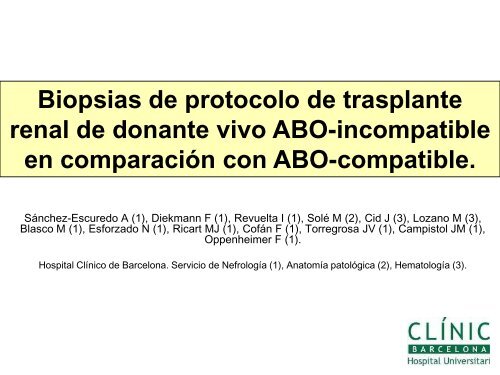
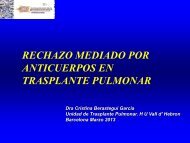
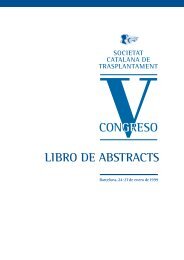
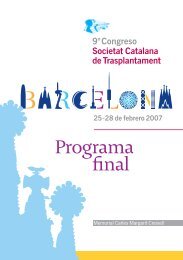
![(Microsoft PowerPoint - Ppt0000008.ppt [S\363lo lectura])](https://img.yumpu.com/39367229/1/190x245/microsoft-powerpoint-ppt0000008ppt-s363lo-lectura.jpg?quality=85)
